Newsletter: How our reporters revealed the shocking death toll of California heat waves

- Share via
This is the Oct. 7, 2021, edition of Boiling Point, a weekly newsletter about climate change and the environment in California and the American West. Sign up here to get it in your inbox.
There’s a lot to say about the oil spill along the Southern California coast. My Los Angeles Times colleagues have been all over this story, documenting the harm to wildlife and wetlands and bringing down the hammer of accountability on government officials and the company whose pipeline ruptured. In the first 48 hours alone, more than 70 L.A. Times journalists played a role in covering the evolving catastrophe. That includes our photographers, who have captured stunning images from the ground and the air.
If you want to help us keep doing this kind of environmental journalism, please subscribe to support our work.
More to come on the oil spill. First I want to tell you about an in-depth investigation we’re publishing today, focused on another grave danger that is also tied to fossil fuels: extreme heat.
Our investigation reveals that California has done a remarkably poor job tracking the number of people dying in heat waves and providing resources to help the most vulnerable stay safe as the planet heats up.
Reporters Anna M. Phillips, Tony Barboza, Ruben Vives and Sean Greene, working with health data analyst Logan Arnold, found that heat likely caused about 3,900 deaths over the previous decade — six times the state’s official tally. This undercounting, they wrote, has contributed to California’s lack of urgency in confronting a public health crisis that is only getting worse.
I’d urge you to stop here and read the main story, featuring heart-wrenching photographs by Genaro Molina, or at least bookmark it for later. We’ve also got several companion pieces:
- How to protect yourself and your loved ones (by Madalyn Amato)
- Access to air conditioning can mean life or death
- The science of how climate change is supercharging heat waves
Extreme heat is the deadliest type of weather event, killing more Americans than hurricanes, floods and wildfires. But it doesn’t usually appear on death certificates, making it hard to track and harder to get policymakers and the public to take seriously.
I was curious what prompted my colleagues to investigate heat deaths, and why they think California has made such a mess of counting and preventing them. So I called up fellow environment reporters Anna M. Phillips and Tony Barboza to ask them.
The following highlights from our conversation are edited and condensed for clarity.
**
ME: So, how did this reporting project come to be?
ANNA: We started talking about this in late 2019. For both of us, we felt like it wasn’t getting covered much nationally. I remember reading that heat was the deadliest of all climate-fueled disasters, and just being really struck by that, and surprised.
TONY: Last year we saw a very bad heat wave in California in late August, going into early September. This was something that normally would have gotten some attention but, happening in the midst of the coronavirus, didn’t get a lot of attention. This was a major disaster, but was it being treated like it? We weren’t seeing that.
We asked the state health department if they could tell us how many people died from that heat wave, and they said basically, we don’t know, we don’t count. And so that really stoked our curiosity.
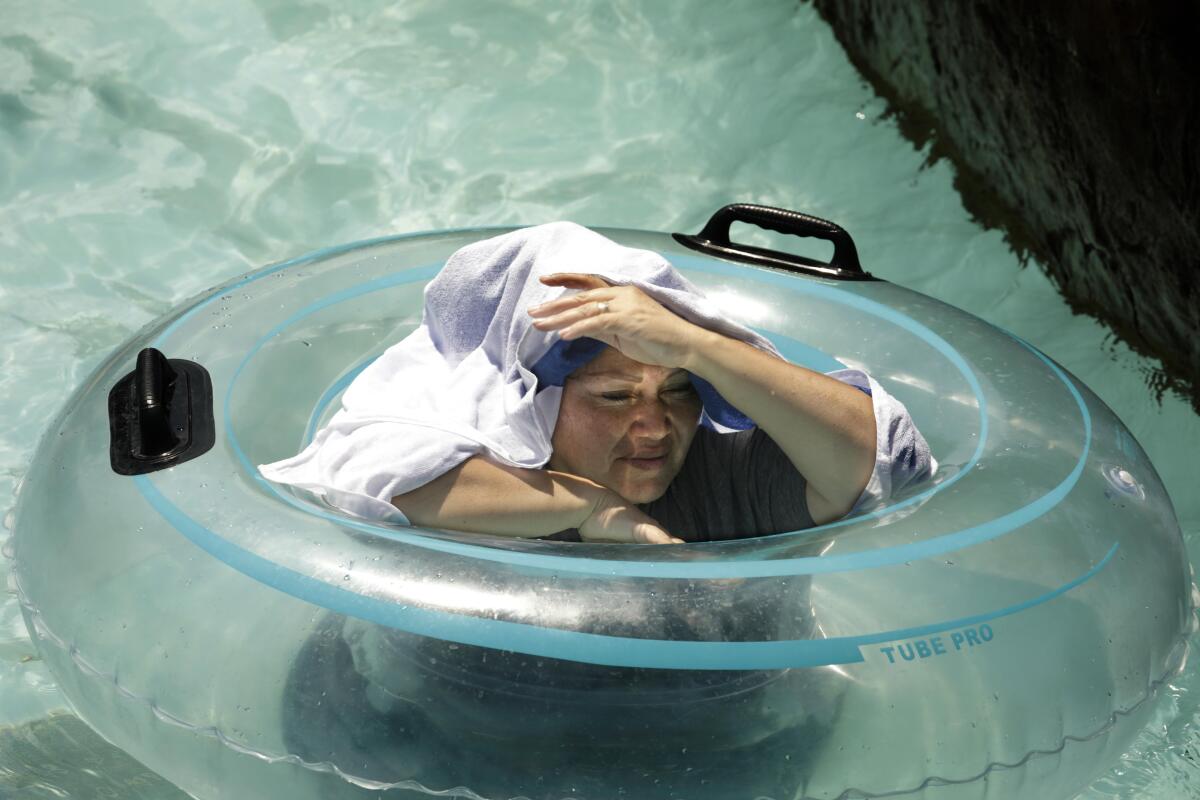
ME: Talk a little more about that heat wave. What made it such a disaster?
TONY: There are a few aspects to it. You’ve got the length of the heat wave that allows the heat to build up in buildings, and literally build up in people’s bodies. You’ve got warmer nights, which make it harder for you to recover and cool down to deal with the heat the next day. And then the mugginess — heat waves in California are growing more humid. That makes it harder for your body to shed heat by sweating.
We also saw record-breaking temperatures on Labor Day weekend. Temperatures in L.A. County reached 121, higher than they’d ever been. And we saw it in the records we reviewed. We could see people dying, coroner’s reports listing extreme heat. And yet we know that only scratches the surface. The documented deaths are so much lower than the true death toll.
ME: There was a striking part in your story about a 70-year-old woman with Alzheimer’s disease who died during that heat wave after being allowed to wander around outside at her assisted living facility in Riverside on a 118-degree day. Anna, you spoke with one of her daughters. What was that conversation like?
ANNA: This is a family that’s still in a lot of pain. Their mother came from Kenya. She was incredibly hardworking, incredibly driven, just a devoted mother and also a devoted caretaker. She spent years working as a home healthcare aide, then as a certified nurse assistant taking care of elderly patients. For her to die in a manner like this, in an assisted living facility, was doubly painful for her children.
ME: You point out in the story that not everyone suffers the consequences of extreme heat equally. The elderly, people who can’t afford air conditioning, people who work in outdoor jobs, Black Californians especially — they’re some of the most vulnerable. You write, “What for some is a nuisance is for others a threat to survival.” What is the takeaway from this story for those of us, like me, who experience heat as more of a nuisance than a threat to survival?
ANNA: When the state puts out these heat alerts, they often say you should be on high alert if you’re elderly, if you have very young children, if you have health conditions that would make you more susceptible to heat illness. But the fact is, none of us are immune, and we should all be taking this very seriously. It’s much like COVID in that sense, where initially there was a real focus on the elderly, and so younger people felt a little bit impervious. And this is not the case.
We have plenty of examples in the story of healthy people who are out working a job, or out for a hike. There are circumstances where you can’t have enough water. It is too hot for you to be outside.
Heat is incredibly dangerous. And it needs to be taken just as seriously as wildfires and earthquakes and floods.
ME: Why do you think California is so far behind on confronting that reality?
TONY: People kept telling us they don’t feel like heat is treated with the seriousness that’s needed. That might be because it’s largely invisible. It’s not a visual, visceral thing like a wildfire clouding the sky with smoke and destroying buildings.
ANNA: It’s sort of a cyclical problem. If you have state agencies that aren’t collecting real-time and comprehensive data about a problem, then they may not understand the full scope of the impact. And if you don’t understand the full scope, then why would you pour millions of dollars into further study, and into protecting vulnerable populations? Or into getting better data?
ME: Hopefully your reporting will make it painfully clear why we need better data and more action.
TONY: Over and over again, health experts told us that the tragedy of extreme heat is that most deaths are preventable. And the steps that are needed to stop them are not that complicated. It’s things like having better alert systems. It’s buddy systems, and keeping track of elderly neighbors who live alone and are at especially high risk during a heat wave. It’s things like assistance so that people can not only buy but also pay for their air conditioning. None of this is rocket science.
We have an entire Air Resources Board in California just for air pollution. But California has no central authority responsible for extreme heat, and there are essentially no temperature limits for places like schools, jails and prisons.
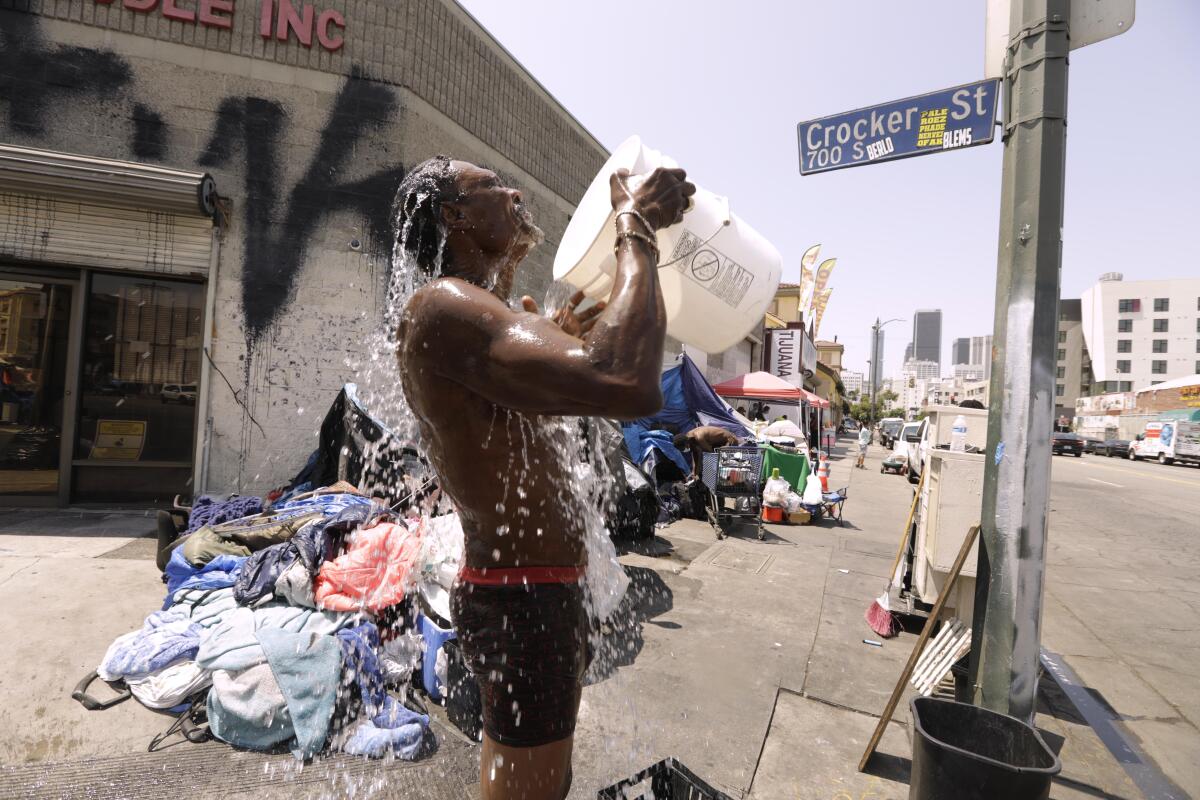
ME: Your story mentions that the $15-billion climate package signed by Gov. Gavin Newsom last month includes $800 million for dealing with extreme heat. How much will that money help?
TONY: It’s hard to say. We heard from advocates who were pushing for more spending on extreme heat that they didn’t get everything they wanted, but this was more than they’d ever gotten.
Still, it’s not necessarily spending that counts. Some of this stuff really isn’t expensive. It’s just collecting data, prioritizing this issue. And the state is still not setting aside as much money for heat as it is for wildfires or most other climate issues.
ME: I saw last month that the Biden administration is writing a workplace safety rule to protect against heat stress. Could that end up helping folks in California?
ANNA: Advocates have been calling for a heat standard for outdoor and indoor workers for years. That would be a big deal. Then you would have the question of enforcement, though. We’ve seen with COVID — in workplaces, in warehouses, in meatpacking plants — that what you have on the books is important, but how thoroughly you enforce it is more important.
And we’re going to have industry pushback. They’re not going to want to spend a lot of money air-conditioning big spaces. So there’s going to be this fight over, what is a safe indoor temperature? Ultimately, the safe temperatures the federal government arrives at are going to tell us how serious they are about protecting people.
ME: Last question: How much worse are the health risks going to get as temperatures continue to rise?
TONY: The heat waves we’re experiencing today seem very extreme. If you fast-forward decades, these types of events are going to be much more commonplace. The real severe heat waves are going to be stronger, higher temperature, longer, and also have less cooling off overnight.
ANNA: California’s elderly population is growing faster than any other age group. At the same time as you have these intensifying heat waves, you also have a large increase of the most vulnerable population. And that is not a good combination.
**
Again, read the stories here. Now let’s talk about that oil spill, and other stuff happening around the West:
OIL SPILL: CONTEXT
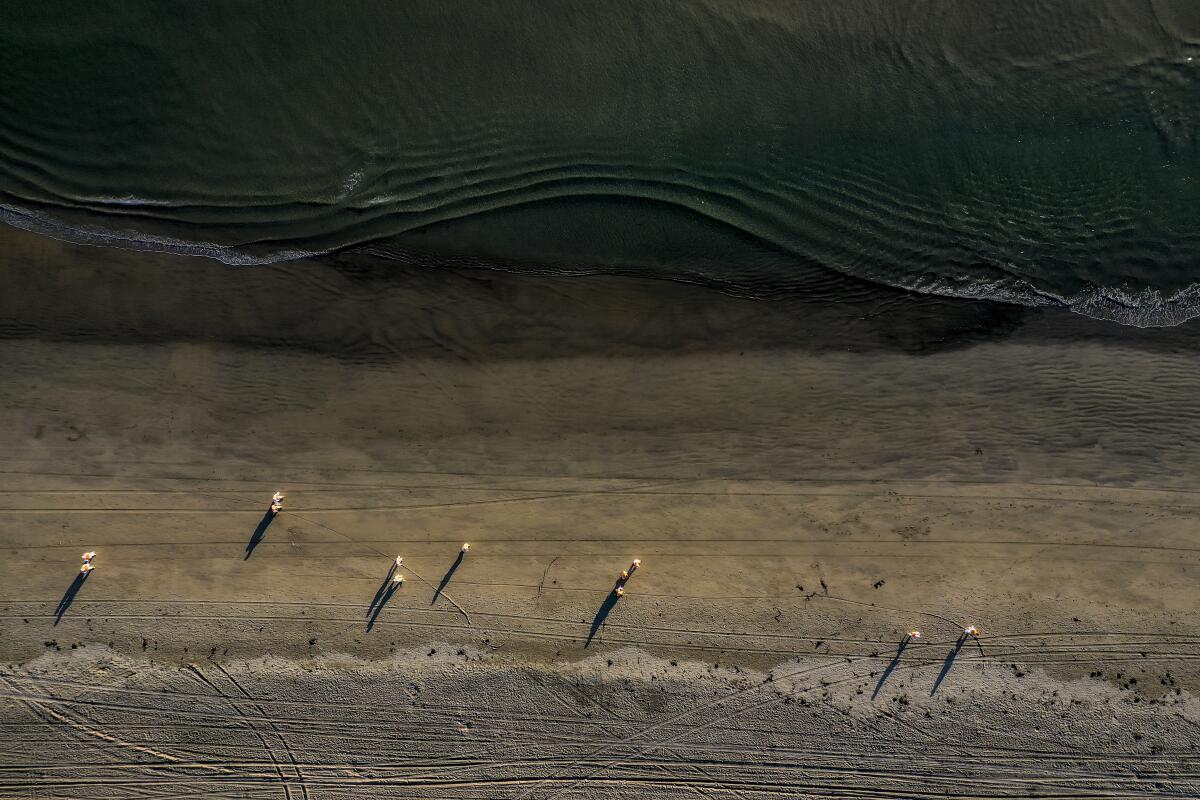
The Orange County incident is a stark reminder that the damage from powering society with fossil fuels is far greater than just a warming planet. I wrote about the robust scientific evidence that replacing oil, gas and coal with renewable energy would not only prevent further spills but save millions of lives through reduced air pollution. Several experts told me the ongoing calamity off the coast highlights the need for Congress to approve President Biden’s $3.5-trillion climate and infrastructure bill.
There’s a long history of oil spills in the Golden State, including the 1969 Santa Barbara disaster that helped launch the environmental movement and has shaped California politics ever since. Columnist Michael Hiltzik writes that now’s the time to finally start learning from these spills by leaving oil in the ground. Columnist Steve Lopez makes a similar case, writing that there’s no safe way to drill offshore. Gov. Newsom and other politicians, meanwhile, are renewing calls to ban oil extraction off the West Coast once and for all, Hannah Fry and Rosanna Xia report. Some Huntington Beach residents feel the same way.
Why does California still have offshore wells, and where are they located? My colleagues Jon Healey, Karen Garcia and Madalyn Amato wrote a great explainer on the state’s long history of coastal drilling, going back to 1896, when extraction began from piers near Santa Barbara. They also tracked down every remaining offshore well and explained how the industry has persisted.
OIL SPILL: WHAT WENT WRONG

A commercial ship may have caused the pipeline rupture by dropping its anchor in the wrong place. That possibility was first reported by The Times and is being investigated by the Coast Guard. If it’s proven out, record shipping traffic at the ports of L.A. and Long Beach could be a contributor to the disaster, although questions remain about the condition of the 41-year-old pipeline. While we wait for answers, here’s a detailed look at how officials manage all the ships and oil tankers waiting to dock. And here’s a view from the air courtesy of Ruben Vives and Luis Sinco, who went up in a monitoring plane with the U.S. Coast Guard.
Even if the immediate cause turns out to have been a ship’s anchor, that doesn’t mean government agencies are off the hook for lax oversight and a slow response. State and federal agencies originally downplayed the spill and didn’t start notifying elected officials until Saturday afternoon, even though they had strong indications of oil on the water Friday night, as first revealed by Times reporting that was later confirmed by the Coast Guard. Only Saturday night did authorities acknowledge a major disaster was in the works. See also this important story on the Bureau of Safety and Environmental Enforcement. The federal agency is supposed to prevent oil spills, but it’s wildly underfunded and the Trump administration undercut its enforcement capacity.
The company that owns the pipeline and oil platform may be at fault too: Federal regulators say it knew about a possible leak around 2:30 a.m. Saturday but didn’t shut off the pipeline until 6:01 a.m. That appears to contradict the timeline offered by Amplify Energy Corp., whose president says the company learned of the leak at 8:09 a.m., The Times’ Laura J. Nelson reports. It’s also worth noting that Amplify emerged from bankruptcy just four years ago and has a long record of regulatory violations.
OIL SPILL: CONSEQUENCES
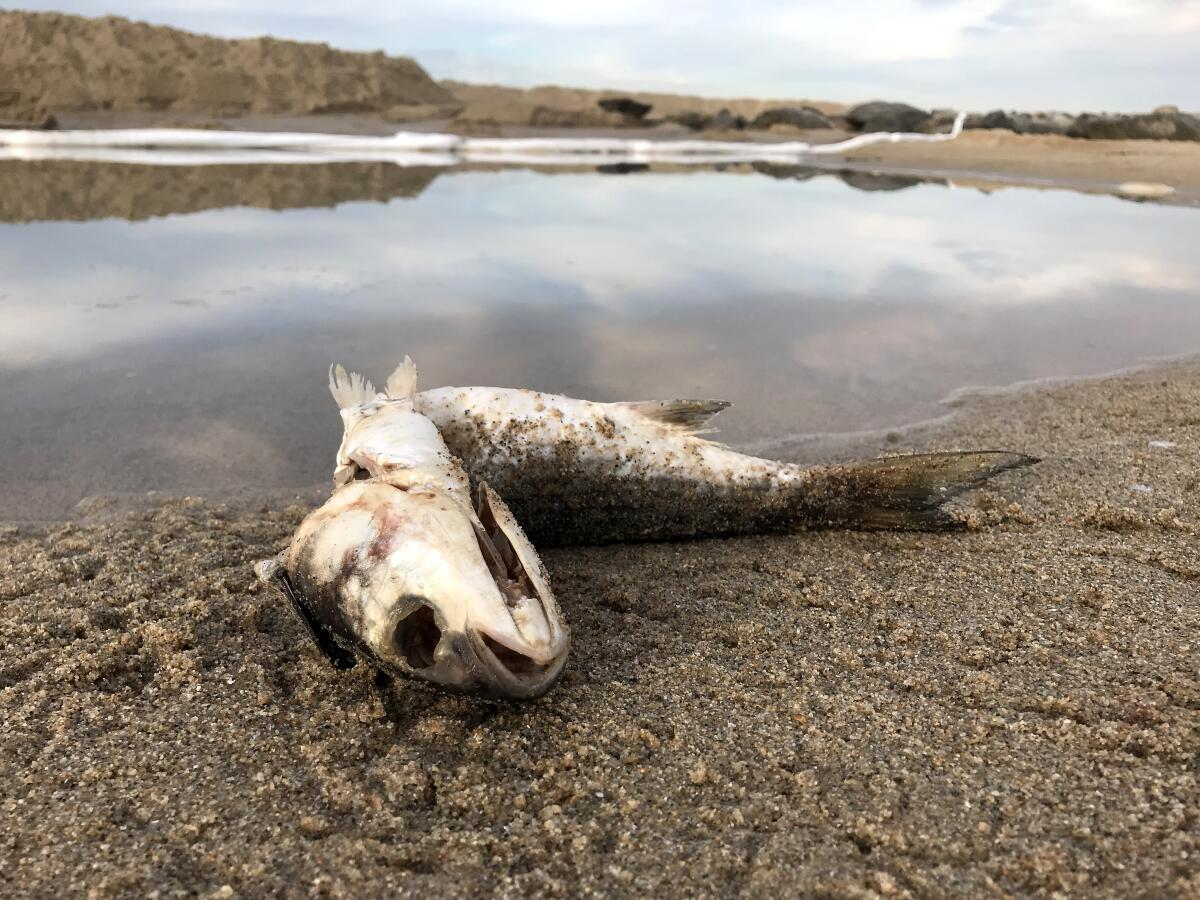
Let’s start with wildlife and wetlands. The full ecological toll won’t be known for months or years, but here’s an early picture of the sensitive habitats and species at risk, and also a detailed look at how oil affects creatures from seabirds and shovelnose guitarfish to tiny sand crabs, and how wildlife rescuers try to help them recover. Reporter Louis Sahagún visited a restored marsh in Huntington Beach, where “brackish ponds were rife with great blue herons, brown pelicans, double-crested cormorants and western gulls preening along shores stained brown by oil,” and “butterflies flitted over knee-high grass soaked in oil.” If you want to help, you can donate materials or money to support cleanup crews; check out this piece by Madalyn Amato for more info.
There are economic consequences too. Lobster fishermen, surf instructors and tourism-based businesses are suffering, and there’s already been a class-action lawsuit filed against the pipeline operator, alleging lost wages and potential exposure to health hazards. I also was struck by this story about a group of painters currently holding an annual outdoor event in Laguna Beach, and this one about a local resident who could taste oil mixing with saltwater as he surfed. The Times’ Joe Mozingo, meanwhile, was surfing with his son Saturday morning, before the public was alerted to the spill; he nearly collided with a frantic fleeing dolphin.
DROUGHT CENTRAL
In Stratford, a small town in California’s Central Valley, teenagers play chase with stray dogs to pass the time and know that opening a business is a losing proposition. But they love the place anyway, even as the heat becomes more excruciating and the land sinks due to farms pumping large amounts of groundwater. Here’s the story from my colleague Priscella Vega on yet another Western town getting hammered by drought, climate change and a history of unsustainable resource extraction.
Los Angeles has agreed to forgo some of its Northern California water supplies, so that nearby cities without other options can get by with what little is available. Los Angeles will draw more water from the Colorado River instead, The Times’ Ian James reports, as part of an agreement with the Metropolitan Water District of Southern California. The powerful water wholesaler commonly known as “Met” also agreed to pay tens of millions of dollars to the San Diego County Water Authority, settling a legal dispute, Joshua Emerson Smith reports for the San Diego Union-Tribune. All that cooperation is well and good, but if Californians don’t step up their conservation, state officials will consider mandatory water restrictions this winter, Ian James reports.
The Walton Family Foundation, which is controlled by the billionaire heirs to the Walmart fortune, has given $200 million to groups involved in Colorado River advocacy, research and journalism. The foundation is a big booster of water markets, arguing they can allocate water efficiently and help keep more of it in rivers, Scott Patterson writes for the Wall Street Journal.
ALONG THE COAST
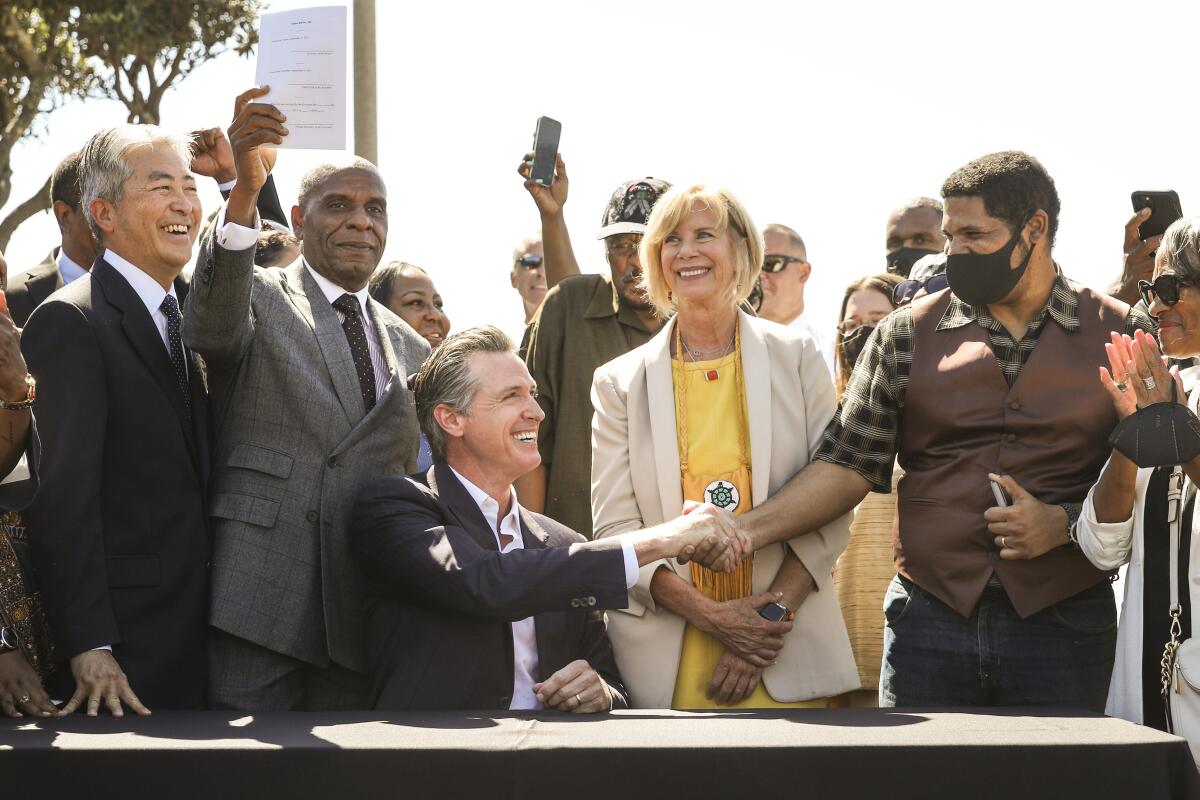
Bruce’s Beach will be returned to the descendants of its original owners, in a landmark victory for reparations advocates. Nearly a century after a Black family was forced by Manhattan Beach officials to forfeit property and give up a thriving business, Gov. Gavin Newsom signed a bill seeking to begin righting that wrong; here’s the story by The Times’ Rosanna Xia, whose reporting last year brought this issue into the spotlight and helped spur the bill’s introduction and passage. See also this first-person piece by Anthony Bruce, whose great-great-grandparents once owned the land. When he returns to Bruce’s Beach, he writes, “I won’t think only of the injustice done to my ancestors. I’ll also think of the progress our country has made.”
For the first time, California renamed a state park as part of an effort to identify and rectify derogatory names. Patrick’s Point State Park, along the Humboldt County coast, was originally named after a settler who was accused of killing a Native American boy and reportedly fled. The park now will be called by the Indigenous Yurok name Sue-meg, Lila Seidman reports.
A picturesque stretch of railroad track in San Clemente was shut down last month after large waves swept in and the ground became unstable. Yes, this is climate-driven sea-level rise in action. More details here from my colleague Anh Do.
AROUND THE WEST
Years after the Aliso Canyon gas blowout, residents say they’re still dealing with health consequences they believe are tied to the leak. They want the Los Angeles County gas storage facility shut down, but state officials just proposed doubling the amount of fuel Southern California Gas Co. is allowed to store there, as I reported along with Leila Miller and Tony Barboza.
The Bureau of Land Management has its first Senate-confirmed director since the Obama administration, with all 50 Democrats voting to confirm Tracy Stone-Manning. Here’s the story from Lisa Friedman at the New York Times. Stone-Manning will have plenty of challenges to deal with, including how best to implement President Biden’s goal of protecting 30% of U.S. lands and waters by 2030. The agency’s then-acting director recently said public lands leased for livestock should count toward the “30 by 30” target, per Jennifer Yachnin at E&E News, frustrating conservationists who say grazing can be environmentally destructive.
The federal government is having trouble hiring and retaining firefighters, and needs to shift some of its focus to treating forests before they burn. That’s what Forest Service chief Randy Moore told Congress last week, as chronicled by my colleague Erin B. Logan. In the meantime, California continues to burn. The KNP Complex fire in the Sierra Nevada spurred new evacuations this week, Hayley Smith writes, and is believed to have burned or passed through 11 sequoia groves, per Lila Seidman. Meanwhile, we just finished what was likely the driest water year on record for parts of Northern California, Alex Wigglesworth reports.
ONE MORE THING
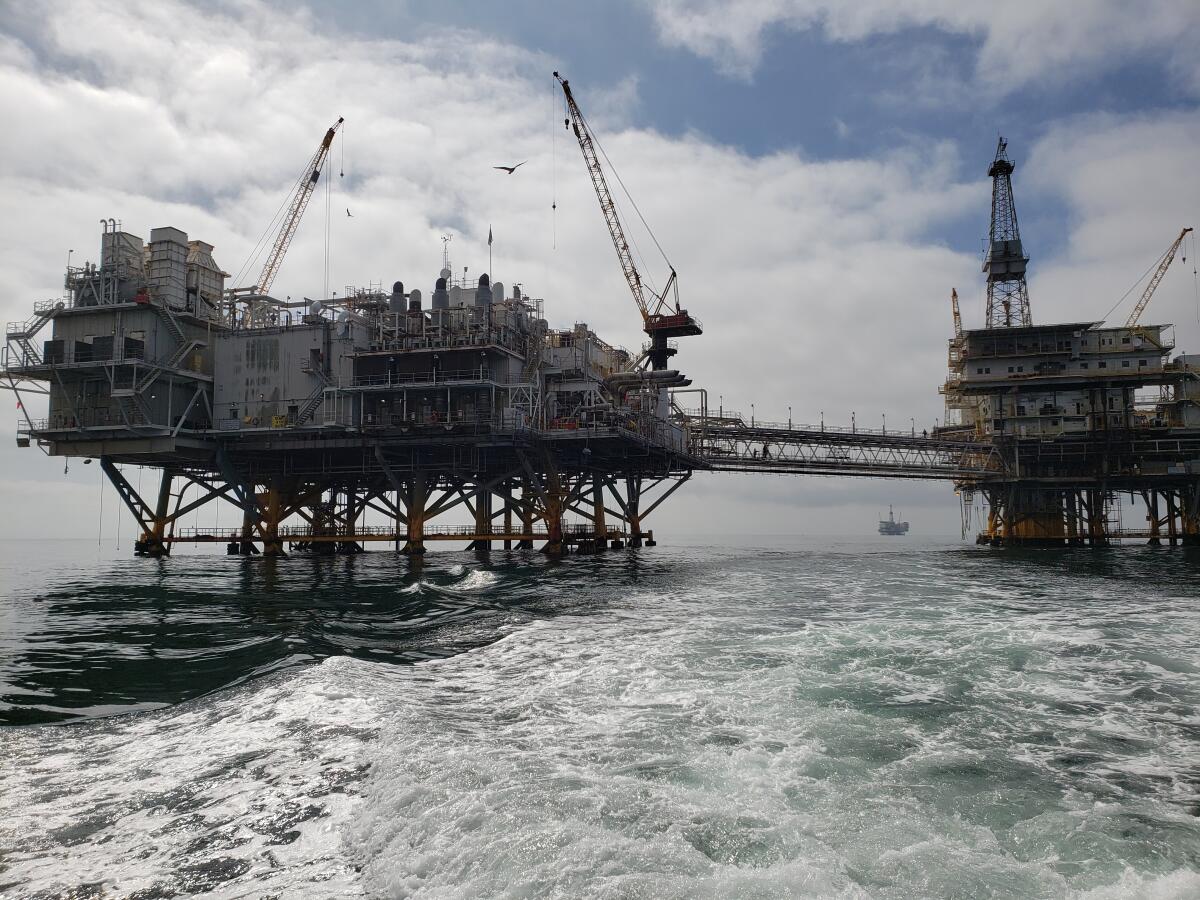
A final oil spill note: As I said in my aforementioned piece on the astonishing amount of harm done by fossil fuels, the British oil company BP paid a $100-million fine after the Deepwater Horizon blowout in the Gulf of Mexico killed an estimated 1 million birds. Those fines resulted from a violation of the Migratory Bird Treaty Act, which has protected birds for a century.
The Trump administration attempted to weaken those protections by reinterpreting the treaty to mean that killing a migratory bird is OK as long as it wasn’t intentional. Now the Biden administration has returned to the original interpretation, Maxine Joselow reports for the Washington Post — meaning companies will still be on the hook for oil spills like Deepwater Horizon.
California passed its own Migratory Bird Protection Act two years ago, meaning a company like Amplify Energy could still be prosecuted or fined for an incident like the Orange County spill. Now that will be the case for the rest of the country too.
We’ll be back in your inbox next week. If you enjoyed this newsletter, please consider forwarding it to your friends and colleagues.




